 What is Contractionary Monetary Policy?
What is Contractionary Monetary Policy?
Definition: A contractionary monetary policy is a governmental economic effort to fight inflation by decreasing the money supply.
When an economy is under an attack of inflation, the central bank must make the appropriate move contain it. In such a scenario, it applies the Contractionary Monetary Policy. The presence of inflation means an economy is inflamed. It results in increased prices of goods and services. It impacts both the nation and the everyday activities of the average person.
Keeping inflation under control involves decreasing the quantity of cash supplied in the marketplace. The Contractionary policy defines the need to increase or decrease; hence it is one of the vital tools, which battle rising inflation.
Let us discuss the primary purpose of the Monetary Policy
Monetary Policy Purpose
The practice of using Contractionary monetary policy dated back to the 1940s and was introduced by John Maynard Keynes. The central bank is in charge of various base interest rates. It means it is in control of any growth produced through the amount of money supplied. When the interest rates are high financial institutions reduce the lending amounts.
A 2% increase in prices will not have any impact on an economy. In any case, it will inspire demand. Nonetheless, even though a little inflation is relatively healthy, it can be damaging when it gets higher. Businesses are forced to produce more to meet the high demands that come with high inflation. Lack of production can only translate to increased prices of the available goods and services.
Implementation of Contractionary Policy
Some of the monetary tools central banks use open market operations, fed fund rate, and the discount rate. Open market operations allow the Fed to sell Treasury notes to member banks, and the payment the banks make to Fed reduces its credit. With the reduced credit, banks will have little money too. Hence they have an opportunity to increase the interest rates.
Quantitative easing, which is the opposite of open market operations, is significantly applicable. It involves buying of bonds and Treasuries by the Fed from its affiliate banks. The purchasing is done using undefinable loans. The fed fund rate is applicable when the Fed wants to reduce the money supply.
The practicability of the use of discount rate is in the charge Fed apply on funds borrowed by banks through the Fed’s discount window. Usually, the fee is meager compared to fed funds rates, but surprisingly, the banks will hardly use the discount window.
Positive Effects of Contractionary Monetary Policy
It shields a booming economy from threats of inflation whereby the government jumps in o control the spending habits.
Inflation tends to increase and decrease prices uncontrollably, resulting in price fluctuation, which causes tension among consumers. However, monetary policy steps in to control and stabilize prices. In the end, inflation is put under control. It keeps spending patterns in motion.
Negative Effects of Contractionary Monetary Policy
A slow economy means there is little production. At this point, it becomes very difficult to put in investment in anything. Capital investment is vulnerable and is likely to suffer the most. It becomes even worse for companies when Contractionary monetary policy is implemented. The economy is strained, and some effects include reduced operations or shutting down companies or anticipated expansions.
Slow production, reduced operations, and shutting down of companies is a direct explanation of the possible loss of jobs. Companies can only afford to hire a limited number of employees.
Meanwhile, high unemployment rates tend to become expensive to the government because it must continue meeting expenditures related to administration and social services.
Consumer confident over a non-performing economy is torn into pieces. Investors cannot invest in a weak economy.
And if you have heard of Hyperinflation, it is different from inflation
Hyperinflation is rare in any economy, but it possible to happen. In any case, it has happened to Hungary, Germany, China, and Argentina. It takes place when there is more than a 50% increase in prices monthly over a specified period. Take, for example, the weekly prices of food could be $500. The next week it shoots to $750, and in the last week of the month, it is $ $1,125. It is severe, can cause severe economic turmoil, but most governments have been able to contain it.
